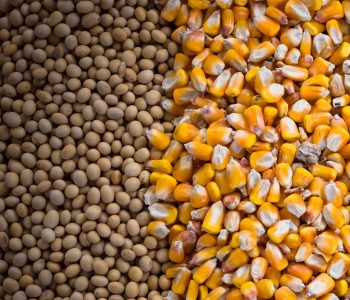The use of exogenous enzymes in monogastric nutrition requires special consideration:
Currently phytase is considered as a broadly used enzyme in animal production. This is partly due to its well known benefits: as it helps to release phosphorus contained in animal diets, which without the use of this enzyme would remain unavailable. Therefore, the use of phytase contributes to lowering inorganic phosphorus inclusion in diets, which in turn reduces phosphorus excretion into the environment.
Carbohydrases, which will be the main topic addressed in this article, are enzymes that have gained great notoriety lately. This is growing interest in these enzymes, is related to their ability to degrade complex carbohydrates found in grains.
The search for alternatives that contribute to reducing the cost of feed without compromising performance in animal nutrition is a major priority. Thus, the use of exogenous enzymes in diets containing alternative grains, such as: wheat, oats, barley and rice bran,has become a well established practice. As this nutritional strategy contributes to improving feed digestibility, while minimizing antinutritional effects and favoring productive parameters.
These feedstuffs have a high concentration of non-starch polysaccharides, which are components of the cell wall of vegetables, which cannot be fully degraded by animal’s endogenous enzymes. This affects the digestibility of this type of ingredients and causes changes in the digestive tract’s viscosity.[register]
Despite what has been previously mentioned, most of the monogastric diets formulated in Brazil are based on corn and soybean meal. Despite being relatively free of non-starch polysaccharides, corn presents high nutritional variability.
Soybean meal is also an ingredient with variable composition and quality, which highly depends on its processing. Presenting 20% of non-starch polysaccharides in its composition, with practically zero digestibility (Rodrigues et al., 2001). It also holds variable levels of certain antinutritional factors, which can compromise the activity of some enzymes within the animal body.
The use of carbohydrases to reduce dietary viscosity, in order to improve the digestibility of structural carbohydrates in animal diets has become a common practice. However, little interest has been given to enzyme supplementation in corn- and soybean-meal based diets. Although these are not considered as viscous grains, the insoluble components of non-starchy polysaccharides found in corn and soybean meal can encapsulate nutrients.which can justify the use of exogenous enzymes.
Some of the activities attributed to exogenous enzymes are: breaking down the cell wall of fibers, reducing viscosity, degrading proteins and complementing the action of endogenous enzymes.
The most practical and simple application of enzyme supplementation in animal nutrition is referred to as “over the top”. Which refers to the addition of enzymes in standard formulations, without modifying nutritional levels. An alternative practice, consists on nutrient reductions in feed with the addition of exogenous enzymes to restore the nutritional value of the standard diet. Aiming to achieve the same performance as that obtained with a diet with recommended nutritional levels (Barbosa et al., 2008).
Increasing the efficiency of ingredients through the inclusion of exogenous enzymes allows nutritionists to reduce nutritional and energy densities of diets, without compromising animal performance. Resulting in significant reductions in final feed costs.
The use of enzyme complexes that combine multiple enzymes is recommended for improving the nutritional value of diets. As these can act on a series of polysaccharides found in the cell wall of grains. Optimizing their use by animals. The benefits are associated to the synergistic action of enzymes on specific components, which translates into better animal performance.
Under this scenario, the use of exogenous enzymes influences animal’s intestinal morphometry, immune response and microbial status. Resulting in health and performance benefits for animals (Macambira et al., 2021).
Thus, the use of exogenous enzymes in monogastric diets has been explored as one of the main tools available for reducing feed costs. Optimizing nutrient and energy use from diets, by enhancing digestibility in these types of animals.
Considering the fluctuation of raw material prices in recent months, feed costs require special attention, as they are a major component of total production costs. Therefore, the use of exogenous enzymes represents a safe and effective alternative to help improve profitability in diets containing alternative ingredients as well as for corn and soybean meal diets.
You may also like to read:“Exogenous enzymes: a tool for maintaining intestinal health”
References available upon request.
[/register]
